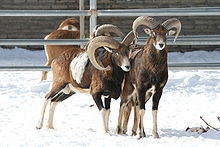Mouflon
| Mouflon | |
|---|---|
 |
|
| A group of Mouflon at the Buffalo Zoo | |
| Scientific classification | |
| Kingdom: | Animalia |
| Phylum: | Chordata |
| Class: | Mammalia |
| Order: | Artiodactyla |
| Family: | Bovidae |
| Subfamily: | Caprinae |
| Genus: | Ovis |
| Species: | O. orientalis |
| Binomial name | |
|
Ovis orientalis Linnaeus, 1758 |
|
| Synonyms | |
|
Ovis aries |
|
Ovis aries
Ovis musimon
Ovis gmelini
The mouflon (Ovis orientalis orientalis group) is a subspecies group of the wild sheep (Ovis orientalis). Populations of O. orientalis can be partitioned into the mouflons (orientalis group) and the urials (vignei group). The mouflon is thought to be one of the two ancestors for all modern domestic sheep breeds.
The wild sheep of Corsica was locally called mufro (male) and mufra (female). The naturalist Buffon rendered this in French as moufflon.
Mouflon have red-brown, short-haired coats with dark back-stripes and light-colored saddle patches. The males are horned; some females are horned, while others are . The horns of mature rams are curved in almost one full revolution (up to 85 cm). Mouflon have shoulder heights of about 0.9 m and body weights of 50 kg (males) and 35 kg (females).
Today, mouflon inhabit the Caucasus, Anatolia, northern and eastern Iraq, and northwestern Iran and Armenia. The range originally stretched further to the Crimean peninsula and the Balkans, where they had already disappeared 3,000 years ago and came back to Bulgaria. Mouflon were introduced to the islands of Corsica, Sardinia, Rhodes, and Cyprus during the neolithic period, perhaps as feral domesticated animals, where they have naturalized in the mountainous interiors of these islands over the past few thousand years, giving rise to the subspecies known as European mouflon (O. orientalis musimon).
On the island of Cyprus, the mouflon or agrino became a different and endemic subspecies known as the Cyprus mouflon (O. o. ophion). The Cyprus mouflon population contains only about 3,000 animals. They are now rare on the islands, but are classified as feral animals by the IUCN. They were later successfully introduced into continental Europe, including Portugal, Spain, France, Germany, central Italy, Switzerland, Austria, the Netherlands, Belgium, the Czech Republic, Poland, Slovakia, Slovenia, Hungary, Bulgaria, Romania, the Canary Islands, and even some northern European countries such as Denmark, Sweden and Finland.
...
Wikipedia

